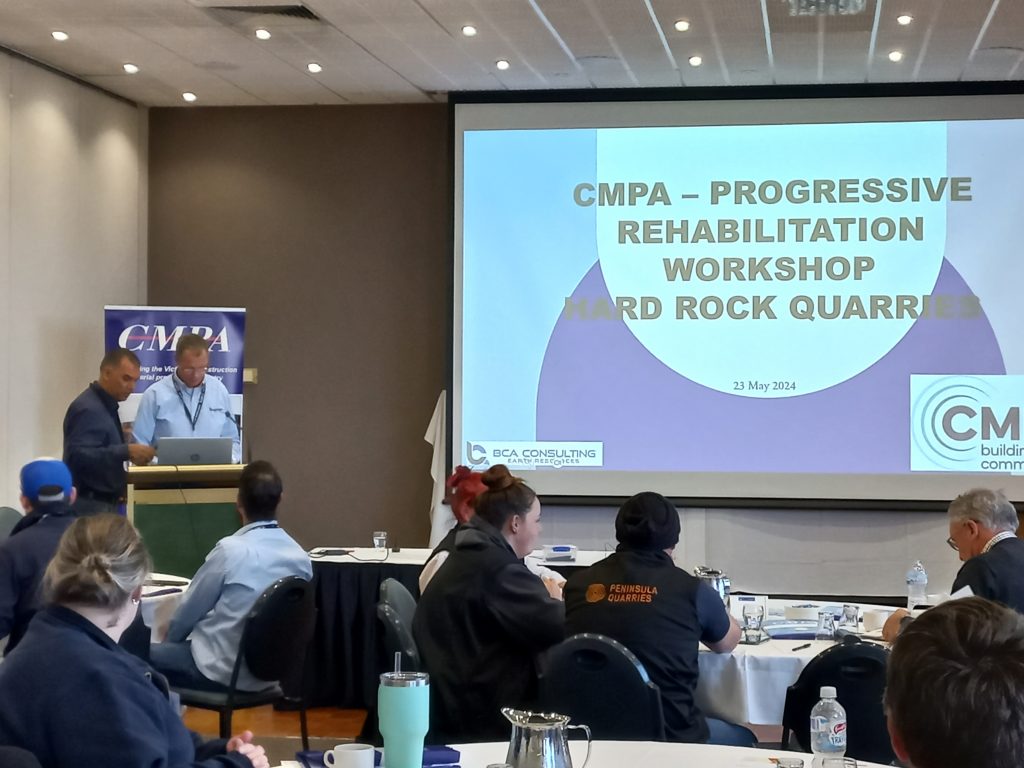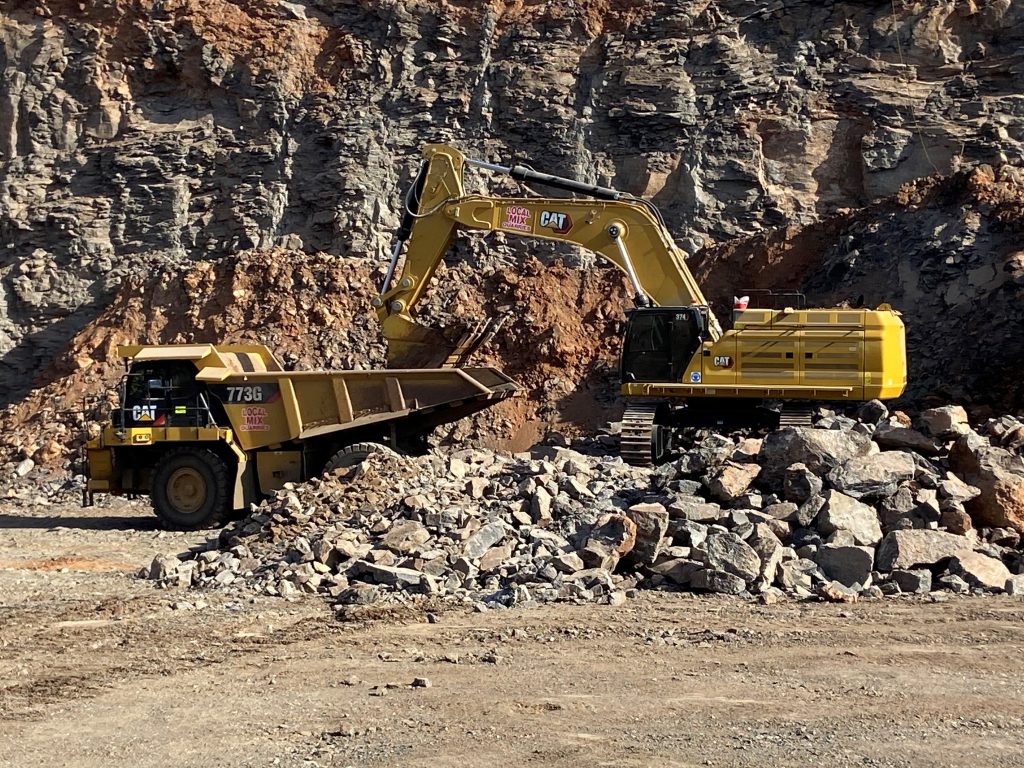25 Years of CMPA – John Mitas
The History of Construction Materials Processors Association (CMPA).
The Construction Materials Processors Association (CMPA) was officially established in late 1990 and incorporated on 25 February 2000, born out of a necessity for a unified voice representing the interests of small to medium-sized businesses within the construction materials industry.
The initial idea for CMPA sprang from a meeting held at the BP station in Epping, where key industry players gathered to discuss the challenges facing their sector. The early meetings were instrumental in laying the groundwork for what would become a pivotal organisation in the industry.

Ron Kerr stated in the 1st issue of CMPA News that the Association was formed to:
- Assist members to enhance viability of their respective businesses
- Represent members
- Minimise legal risk
- Standardise documentation
- Improve outcomes for common benefit
Interviews with Ron Kerr, Sarah Andrew, Glen Jordan, Alan Wilkens, Robbie Matthews, Basil Natoli, Jack Kraan, Jane Sims, John Mawson, Garry Cranny, Raymond Walsh, Dale Elphinstone, Glen Slocombe, Bruce Edward Tim Bird, Grant Phillips, David Jones and comments from Andrew Lumb reveal a shared vision for the CMPA of ensuring fair representation, advocating for safety and environmental standards, and promoting the importance of education and training.
Glen Jordan articulated Ron’s concerns that “the smaller operators were underrepresented with regards to lobbying the government and key agencies and struggled to keep up with the changing legislative requirements.” He said that “it was a slow start, and industry was intrigued and surprised that CMPA survived considering that operating members were in competition.”

Alan Wilkens said that “the Crushed Stone Association was controlled by the corporate sector and the interests of the small operators was not attended to and that the Institute of Quarries Australia (IQA) was focusing on individual member needs. It was fortunate that the Earth Resources Regulator (ERR) was supportive of the formation of CMPA and through its educational initiatives provided a consistent approach to compliance with the OHS Act and other legislation applying to the construction materials sector.”
Robbie Mathews stated that “the independent operators now produce more construction materials than the corporate sector and are important contributors to Victoria’s infrastructure projects. The educational initiatives from CMPA benefitted my company and most of the small operators in Victoria.’
“Ron and I go back a long way., The industry Associations were there to look after the big end of town,” was Basil Natoli’s opening statement. “The lobbying at the time did not focus on the regulatory requirements and training needs of the industry. Rehabilitation bonds and the duty of care requirements under the OHS Act were the big issues then and are still the big issues now.”
Basil articulated that “high rehabilitation bonds are a barrier to entry for small operators and big companies were happy to continue the path of exponential increases to rehabilitation bonds. The Working Safely and the associated training courses were big initiatives and lead the way for other organisations such IQA and Cement Concrete and Aggregates Australia (CCAA) to follow. The CMPA is now a very effective organisation delivering benefits to all its members.”

Jack Kraan said that “regulators and politicians are taking notice of CMPA now, largely due to Ron’s efforts. ERR listens to us now. The combination of consultants and operators through the workshops and functions works well. The key issues for the industry include the length of time for work plan and planning approval, native vegetation, Cultural Heritage Plans and the loss of expertise and knowledge in ERR.”
The partnership between CMPA and Box Hill Institute was able to make the submission and win the tender for funding under the Federal Government’s Workplace English Language and Literacy (WELL) was a program that provided basic education in the workplace for workers. Jane Sims said “the funding spread to other quarry sectors and allowed teachers to travel to quarries across Victoria. The WELL funding has dried up now, but it was very successful in improving literacy in the construction materials sector and assisting with safety initiatives. The partnership with CMPA was also able to focus on training from the bottom as well as the traditional top-down programs like the successful quarry managers courses ran by Box Hill Institute.
John Mawson said that “the CMPA gave the independent operators a common voice and was more specific in Victoria. The IQA had no lobbying capacity and the CCAA was for the corporates. CMPA was and is instrumental in raising the education level for safety, environmental, quality assurance educational and compliance for the construction materials sector in Victoria. The CMPA has published a lot of guidance material and has been able to provide input into government guidelines and regulations. The CMPA has also contributed to improving community understanding of the quarries and as consequence made it easier to attract employees into the sector.”
“The supply of quarry products needs to meet the increasing demand created by the new infrastructure projects In Victoria” stated Garry Cranny. “The complexity of the approval framework with multi agency and community input make it difficult for our industry to respond to the demand. The CMPA provides enormous guidance and educational material and training for OHS and environmental compliance. Our industry is now more transparent, and the community no longer needs to look over our fence to understand how we operate. I was fortunate to follow John Mawson as the chair of the CMPA who encouraged me to take on the role and provided guidance and advice. Ron is the founding father of the CMPA and our industry, and the family and independent quarries in Victoria will not have a stronger advocate.”

Raymond Walsh said that “CMPA was made up of likeminded people that wanted to get their heads around all the legislative requirements. The support from ERR was very useful in helping with understanding the legislative requirements and compliance. The documents developed by CMPA are required by the regulatory agencies and can be adapted to suit individual site requirements, common sense needs to prevail.”
Dale Elphinstone said that “the CMPA is a good industry body and one of its core purposes is to provide a voice for its members and the extractive industry to government and regulators. For CMPA to survive in the long term it must stay relevant, add value to its members and industry and provide a good social environment. It is totally unacceptable to injure people at work and CMPA must continue to drive safety awareness and win the hearts and minds of the people. Ron’s stewardship helps to align in a common direction.”


Glen Slocombe mentioned that “evaluation sessions with Ron displayed the strength of the organisation’s underlying safety culture of listening, challenging and sharing information.”
Bruce Edwards said that “the next generation of leaders at the CMPA have a challenge. They must continue to be relevant with the training and educational initiatives and to continue the good work with the social aspects of the organisation. Public advocacy and public relations are crucial for the industry and should be continued in the future.”
“The common approach in dealing with safety training and quality control issues provided by CMPA was very useful” stated Tim Bird. “The networking opportunities are also important and provide opportunities to bring stakeholders together including the regulators, industry, educators, consultants and suppliers. We are all aware of the importance of accessing our extractive industry resources, CMPA along with other stakeholders has engaged with ERR and government on the stewardship, management and access to these resources.”
Grant Phillips recalls getting a phone call from Ron saying that “the big boys and the Government were not listening” and asking if he was interested in the formation of the association. The CMPA united the people, created responsibility, made people aware of safety and forced a lot of the members to lift their game with regards to quality and safety. Everybody is in the same caboose. It is important to grow, and the only way is to go national. With growth we must stay within the industry, remain independent and practicable. Ron sets a high standard, and he is very passionate about our industry.”

“I have always been close to Ron Kerr,” said David Jones. “He gave me a call that he was forming a new organisation because nothing was happening. I am a founding member of the CMPA. I still believe there is a gap between the training initiatives that CMPA provide and those of the IQA. I was involved with the preparation of the blasting guidelines and the subsequent training and assessment. The CMPA has been successful in attracting a broad spectrum of people from our industry with common objectives.”
Andrew Lumb stated that “Ron Kerr said that for him, overwhelmingly, the main driver in the establishment of the CMPA was the urgent necessity to obtain an effective seat at the table and a voice for the medium and small operators in the industry in dealings with government, the regulator, other agencies and the wider public. The power of a collective group representing
medium and small operators gave them the leverage to be heard and taken notice of, whereas previously as individuals they had virtually no ability to command attention. Hand in hand with this went the necessity to assist members in lifting standards, which the CMPA has been able to do.”

Over the last two decades, the CMPA has grown significantly in both membership and influence. The CMPA’s evolution and history can be traced through various milestones, documented in the Sand & Stone magazine archive and the minutes from early meetings. These records highlight the association’s proactive approach to addressing industry challenges, including legislative and regulatory changes, technological advancements, and access to extractive industry resources.
The CMPA has played a crucial role in promoting best practice within the industry. By organising seminars, workshops, and training sessions, the association has facilitated knowledge sharing and collaboration among its members.

One of the most notable contributions of CMPA has been its impact on lifting safety standards within the industry. Safety has always been a paramount concern for the association, and through relentless advocacy and educational initiatives, CMPA has succeeded in raising awareness and improving safety practices.
CMPA has developed a comprehensive range of educational programs and training initiatives in partnership with Box Hill Institute and other educational providers and experts. These programs were designed to enhance the knowledge and skills of its members. By providing accessible and high-quality training, CMPA has empowered its members to implement safer and better practices in their operations.
As CMPA continues to navigate future challenges and opportunities, its legacy of advocacy, innovation, the passion and leadership demonstrated by Ron Kerr will pave the way for continued success and advancement in the construction materials processing sector.
FOUNDING MEMBERS OF THE CMPA
CMPA Chairperson
- Ron Kerr, Conundrum Holdings (2000-2003)
- Grant Phillips, Gippsland Premium Quarries (2004-2007)
- Tim Bird, ASQ (2008-2010)
- John Mawson, E.B. Mawson & Sons (2011-2013)
- Garry Cranny, Dandy Premix (2014-2021)
- Jason Comben, Matthews Quarries (2022-)
Interviewees
- Sarah Andrew, Conundrum Holdings
- Bruce Edward, William Adams
- Dale Elphinstone, William Adams
- David Jones, Holcim
- Glen Jordon, Systec
- Jack Kraan, Focus CDS Consultants
- Andrew Lumb, Nevett Ford
- Robbie Matthews, Matthews Quarries
- Basil Natoli, BCA Consulting
- Jane Sims, formerly Box Hill TAFE
- Glen Slocombe, William Adams
- Raymond Walsh, Walsh Ballarat Quarries
- Alan Wilkens, E.B. Mawson & Sons

Thank you to John Mitas for conducting the interviews with CMPA’s founding members. The CMPA acknowledges all of your input and hard work over the past 25 years.









You must be logged in to post a comment Login